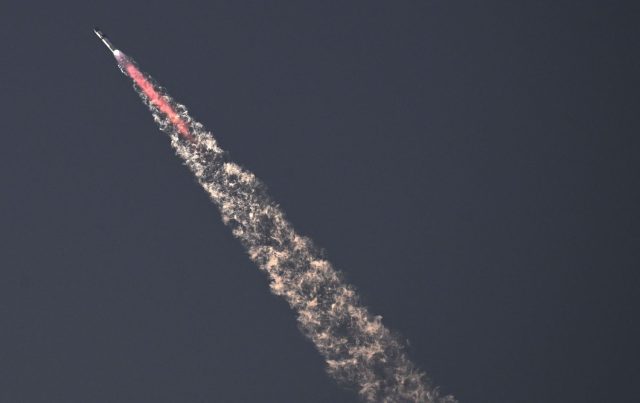
NASA (labels by Ars Technica)
United Launch Alliance and Blue Origin are worried about SpaceX’s plans to launch its enormous Starship rocket from Florida.
In documents submitted to the Federal Aviation Administration last month, ULA and Blue Origin raised concerns about the impact of Starship launch operations on their own activities on Florida’s Space Coast. Blue Origin, Jeff Bezos’ space company, urged the federal government to consider capping the number of Starship launches and landings, test-firings, and other operations, and limiting SpaceX’s activities to particular times.
Elon Musk, founder and CEO of SpaceX, called Blue Origin’s filing with the FAA “an obviously disingenuous response. Not cool of them to try (for the third time) to impede SpaceX’s progress by lawfare.” We’ll get to that in a moment.
The FAA and SpaceX are preparing an environmental impact statement for launches and landings of the Super Heavy booster and Starship rocket at Launch Complex 39A at NASA’s Kennedy Space Center (KSC), while the US Space Force is working with SpaceX on a similar environmental review for Starship flights from Space Launch Complex 37 at nearby Cape Canaveral Space Force Station (CCSFS).
These reviews likely won’t be complete until late 2025, at the earliest, and only then will SpaceX be cleared to launch Starship from Florida. SpaceX also must construct launch infrastructure at both sites, which could take a couple of years. This is already underway at Launch Complex 39A.
Big rocket with a big footprint
During the environmental review process, the FAA should weigh how regular flights of the reusable Starship—as many as 120 launches per year, according to TechCrunch—will affect other launch providers operating at Cape Canaveral, ULA and Blue Origin said. SpaceX’s final proposed launch cadence from each site will be part of draft environmental assessments released for public comment as soon as the end of this year.
SpaceX plans to launch Starlink satellites, customer payloads, and missions to support NASA’s Artemis lunar landings from the launch pads in Florida. Getting a launch pad up and running in Florida is one of several schedule hurdles facing SpaceX’s program to develop a human-rated lunar lander version of Starship, alongside demonstrating orbital refueling.
“I would say we’re doing all we can to pull the schedule to where it needs to be, and we are working with SpaceX to make sure that their timeline, the EIS timeline, and NASA’s all work in parallel as much as we can to achieve our objectives,” she said. “When you’re writing it down on paper just as it is, it looks like there could be some tight areas, but I would say we’re collectively working through it.”
Starship-Super Heavy launches and landings “are expected to have a greater environmental impact than any other launch system currently operating at KSC or CCSFS,” Blue Origin wrote. In its current configuration, Starship is the most powerful rocket in history, and SpaceX is developing a larger version standing 492 feet (150 meters) tall with nearly 15 million pounds (6,700 metric tons) of propellant. This larger variant is the one that will fly from Cape Canaveral.
“It’s a very, very large rocket, and getting bigger,” wrote Tory Bruno, ULA’s CEO, in a post on X. “That quantity of propellant requires an evacuation zone whenever fueled that includes other people’s facilities. A (weekly) launch has injurious sound levels all the way into town. The Cape isn’t meant for a monopoly.”

At SpaceX’s privately owned Starbase launch site in South Texas, the evacuation zone is set at 1.5 miles (2.5 kilometers) when Starship and Super Heavy are filled with methane and liquid oxygen propellants. During an actual launch, the checkpoint is farther back at more than 3 miles (5 kilometers) from the pad.
“The total launch capacity of the Cape will go down if other providers are forced to evacuate their facilities whenever a vehicle is fueled,” Bruno wrote.
We don’t yet know the radius of the keep-out zones for Starship operations in Florida, but Blue Origin wrote that the impact of Starship activities in Florida “may be even greater than at Starbase,” presumably due to the larger rocket SpaceX plans to launch from Cape Canaveral. If this is the case, neighboring launch pads would need to be evacuated during Starship operations.
Purely based on the geography of Cape Canaveral, ULA seems to have the bigger worry. Its launch pad for the Vulcan and Atlas V rocket is located less than 2.2 miles (3.5 kilometers) from Launch Complex 39A (LC-39A). SpaceX’s proposal for up to 44 launches from LC-39A “will result in significant airspace and ground closures, result in acoustic impacts felt at nearby operations, and potentially produce debris, particulates, and property damage,” ULA said.
ULA said these hazards could prevent it from fulfilling its contracts to launch critical national security satellites for the US military.
“As the largest rocket in existence, an accident would inflict serious or even catastrophic damage, while normal launch operations would have a cumulative impact on structures, launch vehicle hardware, and other critical launch support equipment,” ULA said.




















+ There are no comments
Add yours